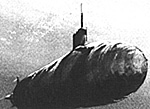
With peace breaking out all over, the United States Navy's Submarine Service is scrambling to find a mission. The Silent Service, as it is called, has long been part of this country's nuclear triad of deterrence. Its fleet of ballistic missile carrying submarines (SSBNs) have maintained a constant undersea vigil ready to make any nuclear aggressor pay for transgressions by obliterating cities and military bases. Undetectable and constantly moving under the oceans of the world, these boats have kept the enemy offbalance and, for the most part, honest in their dealings with the U.S.
Our potential enemies have also built ballistic missile boats, and they too had the advantages of hiding under vast oceans. To find them, the navy created a class of "hunter" submarines (SSNs) designed to locate and destroy enemy submarines. These fast, sophisticated submarines prowled the ocean in search of the enemy. Once located, enemy submarines were stalked, tracked, and kept within range of the SSNs deadly weapons.
The current Los Angeles Class SSN is an incredible piece of machinery. Despite their effectiveness, the ships of the Los Angeles Class were very expensive to build and aged rapidly, becoming outmoded in the face of rapidly advancing technology.
 In the early 1980s, Congress pressed the
Navy to find a smaller, cheaper SSN. The
Navy complied, and the controversial Seawolf
SSN program was begun. Unfortunately, the
three Seawolfs under construction have few
enemy ships to chase; thus, some are skeptical
of the submarine's role in the future.
In the early 1980s, Congress pressed the
Navy to find a smaller, cheaper SSN. The
Navy complied, and the controversial Seawolf
SSN program was begun. Unfortunately, the
three Seawolfs under construction have few
enemy ships to chase; thus, some are skeptical
of the submarine's role in the future.
The Navy has proposed a cheaper version of the Seawolf known as the New Attack Sub (NAS). The Navy would like to build 45-55 NASs at a cost of $1.3 billion per boat. The hunters now have become the hunted-not by the enemy, but by the Government Accounting Office.
Back to Table of Contents #5
© Copyright 1995 by One Small Step, Inc.